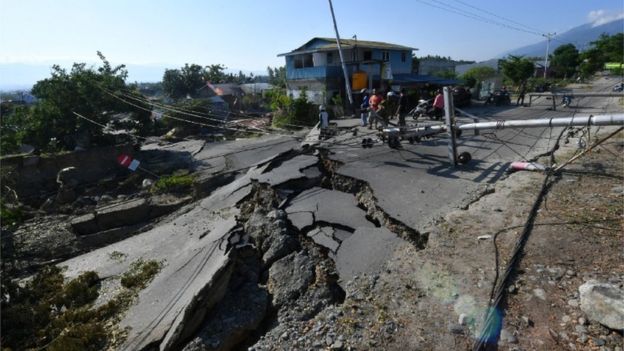A picture of large-scale destruction is emerging in and around the Indonesian city of Palu after an earthquake and tsunami struck on Friday.
At least 832 people are confirmed to have died but that figure is expected to rise sharply as more remote areas are reached.
The authorities have said they will begin burying victims in mass graves, fearing disease could begin to spread.
Dozens of people are thought to be trapped alive under the rubble.
In Palu, rescuers are awaiting heavy machinery to search the ruins of a hotel and a shopping centre as aftershocks made it unsafe for them to go in.
“Communication is limited, heavy machinery is limited… it’s not enough for the numbers of buildings that collapsed,” said Sutopo Purwo Nugroho, spokesman for the National Disaster Mitigation Agency.
A tsunami warning had been issued after the magnitude-7.5 earthquake hit on Friday, but it is unclear whether it was still in place when the waves hit.
Videos show people screaming as 6m-high waves power over the beach – where a festival was being set-up – sweeping up everything in their path.
Indonesian President Joko Widodo visited the region to urge a “day and night” effort to rescue survivors.
Mr Widodo has also agreed to accept international help for disaster response and relief, Thomas Lembong, the head of the Indonesian investment board said on Twitter on Monday.
Meanwhile, Indonesia’s justice ministry is reporting that 1,200 convicts escaped from three different detention facilities in the Sulawesi region following the earthquake and tsunami.
The earthquake was powerful but shallow and with more lateral than vertical movement, not typically the kind of tremor that sets off tsunamis.
Vice-President Jusuf Kalla has said the final death toll could be in the thousands while the Red Cross estimates that more than 1.6 million people have been affected.
A sophisticated tsunami warning system was put in place across the whole Pacific region after the 2004 disaster, which killed nearly a quarter of a million people.
It remains unclear why it was not effective this time, but Mr Nugroho said Indonesia’s part of the network has suffered from a lack of funding.
Source: BBC


